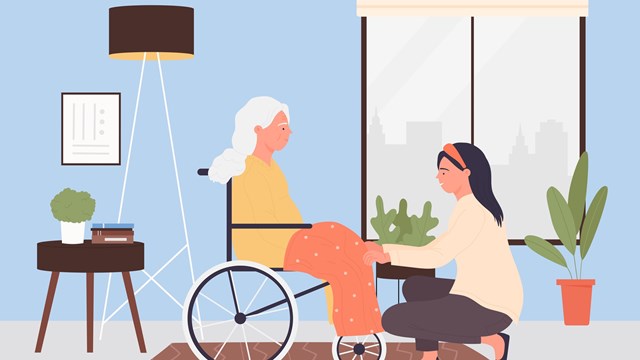
Patricia is a 65 year-old woman who is in good physical and mental shape. She exercises daily, sees her physician regularly and is active in the community. She lives alone in an apartment and doesn't even want to consider moving to an assisted living center or nursing home when the time comes that she has difficulty caring for herself. Patricia prefers to age right where she is, in her own home that she loves so much.
Depending on where Patricia lives, she may not have to move; she can simply "age in place," thanks to a relatively recent phenomenon known as a NORC, or "naturally-occurring retirement community." NORCs are apartment buildings, housing complexes or neighborhoods for tenants of all ages that weren't originally designed or built for seniors; however, over time, these buildings have included a significant number-often more than 50 percent-of residents who are aged 60 and older. As these tenants age, NORCs can come to include everything from social activities to supportive healthcare assistance and other services to meet their needs.
"Everyone wants to stay in their home, and we need to be creative, because healthcare can't absorb us," says Stella Henry, R.N. author of the upcoming book, The Expert's Guide on Eldercare: Compassionate Solutions to Difficult Choices (HarperCollins Publishers). "The trick to how you keep someone at home is to foster independence."
The NORC Numbers
According to the United Hospital Fund, close to 400,000 of the approximately 1.25 million seniors in New York City live in a NORC. And with over 76 million Baby Boomers scheduled to retire from the workforce and eyeing their golden years, the number of NORC communities is growing.
Currently, there are some 27 NORCs located in New York City. Seven of these programs exist in New York City Housing Authority developments. Some NORC programs are exclusively funded by the New York State Office for the Aging, while others receive state assistance as well as funding from the New York City Department for the Aging.
"New York City in particular is a location where seniors can stay in a place far longer than elsewhere," says Jeff Levine, president of Manhattan's Levine Builders, a company that has built several senior buildings, (not to be confused with assisted living communities, which are a different kind of residence). One such project is a building at 171 Lexington Avenue, a 41-unit co-op for low-income senior citizens. Each apartment includes various handicapped adaptable features, including emergency pull cords.
What makes a tough city like New York so hospitable to seniors?
There are several reasons, says Levine. "Rent regulation has kept costs down, and coupled with the fact that this is a dense urban location with opportunities for home care services like food delivery and other services, it's an economical and relatively easy place for people aging in place."
A New Industry
Designing for seniors aging in place has even lead to a whole new certification program with the National Association of Home Builders (NAHB). The Certified Aging-in-Place Specialist (CAPS) designation program teaches contractors and designers the technical, business management, and customer service skills essential to competing in the fastest growing segment of the residential remodeling industry: home modifications for the aging.
And the concept is catching on. Sixty-one percent of respondents to an NAHB survey said their company was involved in home modification related to aging in place. About 71 percent of remodelers did aging-in-place work for homes headed by owners in the 55-64 year-old age group, and 62 percent did such work for clients over 65 years old. About 14 percent of remodelers stated that aging-in-place work requests have increased significantly over the past five years, and more than 60 percent reported seeing some increase.
Aesthetics and Abilities
"Aging in place means living in one's home safely, independently and comfortably regardless of age, income or ability level," said Remodelers Council chairman Doug Sutton Sr., in a statement released by the NAHB. "It means remaining in a familiar environment throughout one's maturing years, and enjoying the familiar daily rituals and the special events that enrich all our lives. Remodeling for aging in place demands sensitive integration of myriad functional and design considerations into a unified, aesthetically pleasing whole."
What needs to be considered when designing for senior shareholders or unit owners? There are two main factors to consider: design with aesthetics in mind, which means that a home's appearance should not be blatantly dictated by disability or impairment, and the design should not just address the physical needs of aging, but the cognitive needs as well.
"For example," says Mark Warner, architect and owner of Ageless Design in Jupiter, Florida, "You have to create a successful, failure-free environment for those with Alzheimer's and dementia There are certain colors, patterns, and contrasts that work better than others, and potential dangers must be minimized."
Designing with aesthetics in mind is also important to the mental and emotional well-being of the resident. "It's important to recognize a sense of self and identity and that the tenants don't want to be identified just as an old person or someone with a disability," says Riley. "You can actually design features it so that the apartment is functional, and yet visitors would have no idea that the building has been equipped in this way."
New Tech for Older Residents
It is possible to retrofit an existing building to make it more senior-friendly. According to the NAHB Senior Housing Council, one of the most common aging-in-place features in new and remodeled homes (which can also be considered in two-story or duplex apartments) is the presence of at least one bedroom and bathroom on the first floor. First-floor living remains a high priority for many consumers, especially older adults. Having a full bath and a master bedroom on the main floor makes it easier for those who have trouble climbing stairs. Having entrances without steps creates easier access, as well as wider doors and hallways.
Lighting is also another major issue for older tenants. As a person's eyesight changes, appropriate lighting with adjustable controls or dimmers can be installed to customize light depending on a resident's needs at any given moment. Among the more inexpensive and easy-to-do modifications are installing conveniently located and easy-to-operate controls and handles, as well as non-slip floors and grab bars to prevent falls. Light switches can be easily converted to toggle switches, doorknobs to levers, and electrical switches and outlets can be repositioned as needed. For the hearing impaired, special doorbells can be installed that vibrate or light up.
Technological advancements are also helping to create safer aging-in-place residences. "Technology and 'smart homes' are having a heyday with this," says Henry. "There are now sensors that can let you know how well tenants are moving around, or if their gait changes. There are chairs that will let you know if the person gets up, and even pill dispensers that actually remind you to take your medications."
If a board and building management want to make apartments and common areas more accessible and senior-friendly, Henry suggests they start by knowing their market. "Who is your market and who are you trying to attract?" says Henry. "If your residents are more alert and not cognitively impaired, they'll want larger living quarters. If many have early stages of dementia, smaller rooms are safer and more appropriate."
"The important thing that we find relocating or having to change is that our personal space is personal," says Henry. "The more that we can keep what is there, the better it will remind us of who we are. That homeyness makes a huge difference."
For more aging-in-place resources, visit the following websites: seniorsafehome.com, ageinplace.org, www.homemods.org and thealzheimersstore.com.






Leave a Comment